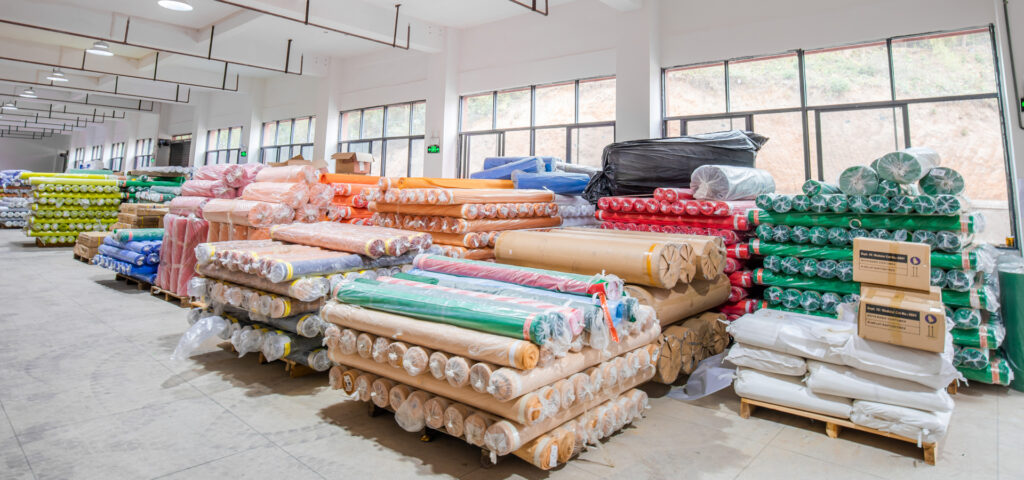As a clothing export manager with over 15 years in the industry, I’ve seen factories lose profits, delay shipments, and damage client relationships over one critical mistake: choosing the wrong fabric. Whether you’re producing a line of everyday t-shirts or high-performance outdoor gear, the fabric you select directly impacts quality, cost, durability, and even your brand’s reputation.
This guide will walk you through the key factors to consider when picking fabrics for your factory, helping you avoid common pitfalls and build a supply chain that delivers consistent, profitable results.

1. Start with Your Product’s Purpose: Function Over Fashion
The first rule of fabric selection? Match the fabric to the product’s intended use. A fabric that works for a casual summer dress won’t cut it for a winter jacket, and vice versa.
- Everyday Wear (Casual/T-Shirt): Prioritize comfort and breathability. Cotton (soft, absorbent) or cotton-poly blends (wrinkle-resistant) are go-to choices. For example, a factory producing school uniforms might opt for pre-shrunk, 100% ring-spun cotton to ensure softness and reduce post-wash shrinkage.
- Performance Gear (Sportswear/Outdoor): Focus on functionality. Moisture-wicking fabrics (polyester, nylon) keep sweat away from the skin, while stretch blends (spandex, elastane) enhance mobility. A client in the fitness industry recently switched to a polyester-spandex blend for their leggings—customer complaints about “sagging” dropped by 80%.
- Luxury/Apparel (Evening Wear/Silk Blends): Emphasize texture and drape. Silk (natural luster), satin (smooth, shiny), or velvet (luxurious pile) are ideal. A high-end boutique we work with uses 100% mulberry silk for their evening gowns—clients specifically cite the “buttery softness” as a key selling point.
2. Evaluate Fabric Performance: Durability Meets Durability
A fabric might look great on a hanger, but how does it hold up after washing, stretching, or exposure to the elements? Here’s what to test:
- Strength & Tear Resistance: For workwear or children’s clothing, use fabrics with high tensile strength (e.g., denim, canvas). A factory producing work uniforms for construction workers now uses 12-ounce duck canvas—tear resistance increased by 50% compared to lighter cotton.
- Colorfastness: Dye migration or fading ruins customer trust. Look for fabrics with OEKO-TEX® certification (ensures safe, colorfast dyes) or conduct a simple “rub test”: rub a wet white cloth on the fabric—if no color transfers, it’s colorfast.
- Shrinkage & Wrinkling: Pre-shrunk cotton or synthetic blends (polyester) reduce post-wash shrinkage. For a factory making hotel linens, we recommend 100% cotton percale with a 200+ thread count—it resists wrinkles and stays crisp after multiple washes.
3. Cost vs. Value: Don’t Sacrifice Quality for the Lowest Bid
It’s tempting to choose the cheapest fabric, but hidden costs can derail profits. Here’s how to balance affordability and quality:
- Upfront Cost vs. Long-Term Savings: A $2/yd fabric might save $10,000 on a 50,000-yard order, but if it pills (forms small balls) after washing, returns could cost $15,000. Invest in slightly pricier, durable fabrics (e.g., combed cotton instead of carded) to reduce defect rates.
- Supplier Transparency: Ask for a breakdown of fabric costs (fiber sourcing, dyeing, finishing). Factories that source locally (e.g., Indian cotton, Turkish denim) often offer lower prices due to reduced shipping.
- Waste Reduction: Choose fabrics with minimal selvedge (the finished edge of the fabric) or wider widths (e.g., 60” instead of 45”) to reduce offcuts. A client in Brazil switched to 60”-wide fabric for their summer dresses—fabric waste dropped by 30%, saving $8,000/month.
4. Sustainability: Meet Consumer and Regulatory Demands
Today’s buyers (and regulators) demand eco-friendly practices. Choosing sustainable fabrics isn’t just ethical—it’s good for business.
- Eco-Certified Materials: Look for GOTS (Global Organic Textile Standard) for organic cotton, OCS (Organic Content Standard) for recycled materials, or Bluesign® for low-impact dyes. A factory in Portugal now uses GOTS-certified organic cotton for baby clothes—sales increased by 25% after highlighting “chemical-free” on labels.
- Recycled Fibers: Blends with recycled polyester (rPET) or ocean plastic reduce reliance on virgin materials. A sportswear brand we partner with uses 50% rPET in their leggings—customers love the “eco-story,” and production costs are 10% lower than virgin polyester.
- Local Sourcing: Reducing transportation emissions by sourcing fabrics regionally (e.g., using European linen for Mediterranean brands) can also lower tariffs and lead times.
5. Partner with Reliable Suppliers: Communication is Key
Even the best fabric won’t help if your supplier can’t deliver consistently. Here’s how to build strong relationships:
- Request Samples: Always ask for fabric swatches before placing a large order. Test them for color, texture, and performance (e.g., wash a sample to check shrinkage). A factory in Vietnam once skipped sample testing—500 yards of fabric arrived discolored, costing $20,000 in reorders.
- Clarify Lead Times: Ask about production timelines for fabric orders. A supplier with a 30-day lead time is better than one with 15 days but frequent delays.
- Negotiate MOQs (Minimum Order Quantities): If you’re a small factory, negotiate lower MOQs (e.g., 100 yards instead of 500) to test new fabrics without risking excess inventory.
Red Flags to Avoid
- Vague Specifications: If a supplier can’t provide a fabric tech pack (details on weight, weave, fiber content), walk away.
- Overpromising: No fabric is “100% wrinkle-free” or “indestructible.” Be wary of claims that sound too good.
- Poor Documentation: Ensure the supplier provides certificates (OEKO-TEX, GOTS) and compliance docs (REACH for EU markets).
Final Thoughts: Fabric Selection is a Strategic Investment
Choosing the right fabric isn’t just about “picking a material”—it’s about aligning with your product’s purpose, customer expectations, and business goals. By prioritizing performance, cost-effectiveness, and sustainability, you’ll build a factory reputation for quality that keeps clients coming back.
At Sheen, we specialize in connecting factories with premium, verified fabrics—from organic cotton to high-performance synthetics. Our team handles everything from sourcing to quality checks, so you can focus on what you do best: making great clothes.
Ready to upgrade your fabric game? Visit our [Sheen Blog] for in-depth guides on fabric testing, supplier negotiations, and case studies of factories that transformed their product lines. Have questions about specs, pricing, or logistics? Drop us an inquiry—we’re here to help you stitch success, one fabric at a time.

